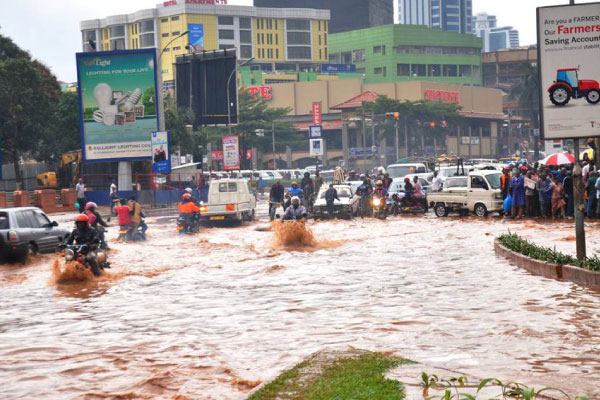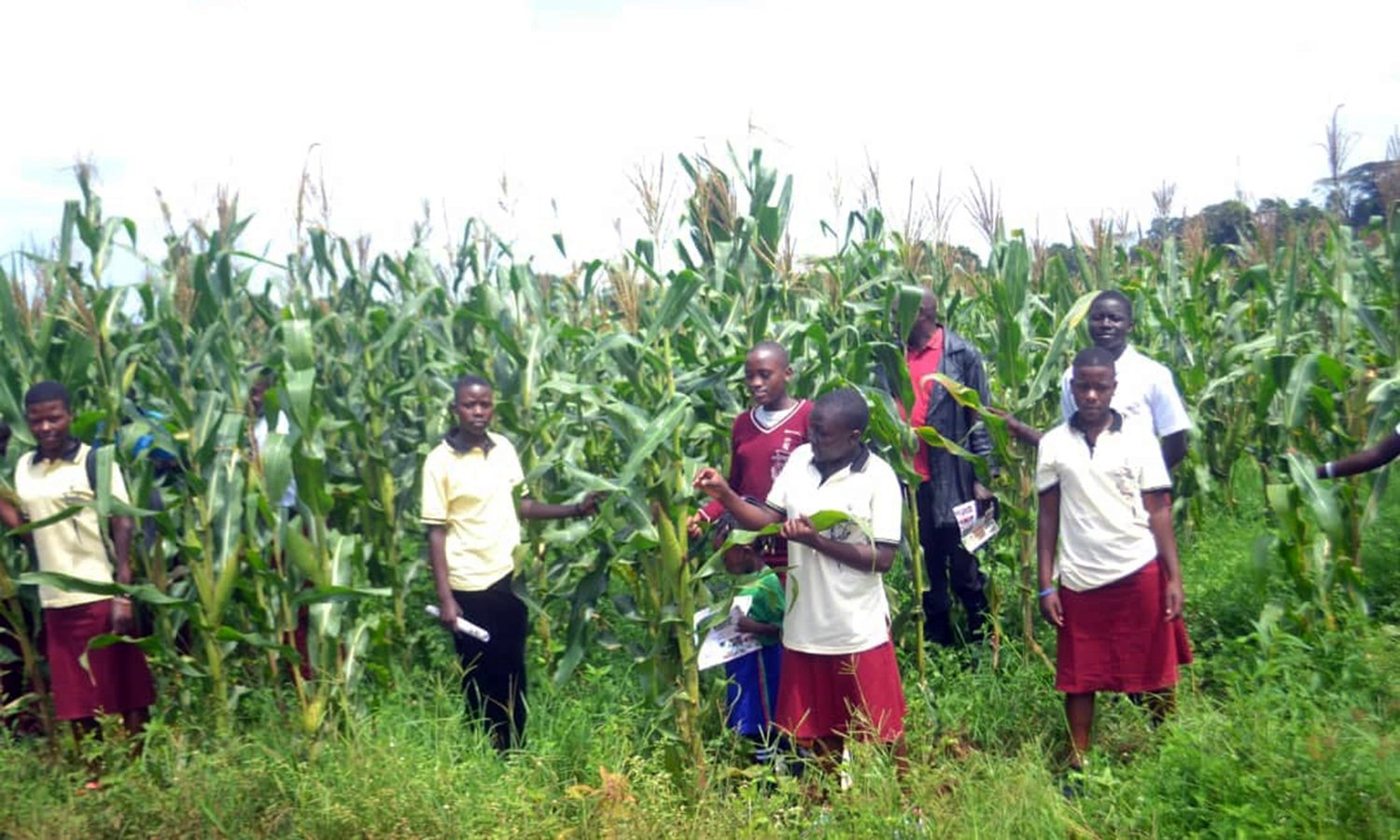Why Kampala keeps flooding

Motorists drive through the flooded Queen’s Way junction in Kampala recently. FILE PHOTO
What you need to know:
- Dr Bateganya further attributes the flooding challenges in Kampala to encroachment on wetlands, which, he says, are supposed to be catchment areas
- But Mr Emmanuel Sserunjogi, the Kawempe Division mayor, says although KCCA contracted concessioners to manage waste in Kampala, they do not have the capacity to do so because of the high number of tonnes of garbage produced in the entire city
Kampala- Residents scramble to cross the road by a meticulously makeshift wooden bridge planted over a large stinking pool of water in Bwaise III Zone, Kawempe Division.
Marabou storks timidly hover as some bare-chested children wade through the stagnant water to collect scrap for sale. The pool of water emerged just a couple of days ago after the skies furiously opened, causing untold damage.
Bwaise, which slightly lies above the drainage channel on the Northern Bypass, has always been an area prone to flooding.
The ramshackled housing units around this place always fall prey to the brunt of this natural calamity whenever there is a heavy downpour.
“I have lived in this place for one decade now and this is how the situation has been like despite pledges by authorities to improve the situation. The situation becomes worse when water spills in the house, leaving us stranded the whole night,” recounts Ms Caroline Nabagala.
The emotive single mother of two says she would have relocated to a better place but she is constrained by money. The harrowing tales of other residents in the vicinity are eye-popping.
Bwaise is just a tip of the iceberg of the places affected by persistent flooding in Kampala, putting authorities in the spotlight for failing to address the issue.
During the rainy season, traders, motorists and other city residents are not spared either, causing financial losses.
Affected areas
City suburbs such as Kasubi, Katanga, Kisenyi, Nalukolongo, Kabuusu, Katwe, Namungoona, and Kinawataka among others are some of the most affected places.
Other flooding-prone areas in the city include Queen’s Way, Ssebaana Kizito Road (Former Nakivubo Mews), Kabuusu junction, Jinja Road roundabout and Kyambogo-Banda, among others.
The previous floods have left dozens dead.
Since its establishment in 2011, Kampala Capital City Authority (KCCA) has upgraded a number of drainage channels to divert floods. However, the problem seems far from over.
Dr Najib Lukooya Bateganya, the KCCA director for environment and sanitation, says although there are primary drainage channels in place, these need to be complemented with secondary drainages to reduce the volume of water that is accommodated by the former.
“The problem is that we have the main drainages, which are at times overpowered by the heavy run-off waters. These main channels such as Nakivubo ought to be helped by the small drainages to ease the flow. What we are now doing is upgrading more drainages to help the main ones, so that we can get rid of the problem of persistent flooding,” he says.
However, Dr Bateganya notes that the public has always let down KCCA in its bid to fight flooding because they dump waste in the drainages, which triggers backflow of water.
Public blamed
“That has been our biggest challenge as authorities because the public hasn’t complied with regulations. For instance, when you walk around, you will see plastics and other waste dumped in drainages, which is very absurd,” he says.
He says they are engaging city leaders to sensitise people about keeping drainages free of waste.
Dr Bateganya further attributes the flooding challenges in Kampala to encroachment on wetlands, which, he says, are supposed to be catchment areas.
Currently, many factories and houses have been built in wetlands despite the existing law. But authorities at times just look on because some developers wield much influence and are connected to the powers that be.
But Mr Emmanuel Sserunjogi, the Kawempe Division mayor, says although KCCA contracted concessioners to manage waste in Kampala, they do not have the capacity to do so because of the high number of tonnes of garbage produced in the entire city.
A statutory audit report released by Mr Moses Bwire, the KCCA director for internal audit, poked holes in the operations of the contracted garbage collection companies over incompetence.
This implies that residents are compelled to dump garbage anywhere because the services are hardly accessible.
To reduce flooding, Mr Sserunjogi reveals that he has embarked on a campaign in the entire division to clean all the drainage channels to allow easy flow of water during the rainy season.
“This is a big problem which we must collectively fight because it tarnishes the image of Kampala city. The situation is always appalling shortly after the downpour, hence exposing residents to danger. I call upon my fellow leaders to mobile, sensitise and take part in cleaning all places that block water flow,” he says.
The lowland areas of Kampala, coupled with the poor quality soils to absorb water, Dr Bateganya says, make the city susceptible to flooding.
Dr Amin Tamale Kiggundu, a lecturer of planning and urban development at Makerere University, says flooding is linked to climate change and changing weather patterns.
But he attributes flooding in the city to most settlements that have been established in areas that were once wetlands or swamps. Flooding becomes inevitable whenever it rains. To mitigate this calamity, Dr Kiggundu says Kampala needs a good storm water management system, which should focus on preserving critical green spaces such as Centenary Park, protecting the wetlands from encroachment and fostering plans that aim to harvest rain water.
Building laws
“The building laws in the city need to change by forcing developers to leave some portion of their land unpaved so that water can just be absorbed without necessarily flowing,” he says.
While addressing journalists on the status of city roads last week, Mr Andrew Kitaka, the KCCA director of engineering and technical services, revealed that upgrading of Kampala’s drainage channels is yet to start.
“The study for updating of the drainage master plan for Kampala was completed in 2017. This study has provided valuable information for the planning of the required improvement of Kampala’s drainage system, the locations and extents flood prone areas as well as guidance on mitigation measures for reduction of surface run off among others,” Eng Kitaka said.
He noted that the upgrade of these drainage channels had stalled because there was no any study on which KCCA would base on to commence construction works.
Currently, KCCA is constructing city roads and upgrading drainage channels in all the five divisions to improve urban mobility and reduce flooding. The five-year project is being funded by the World Bank.



